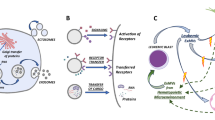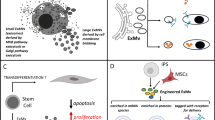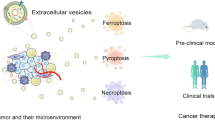Abstract
Normal and malignant cells shed from their surface membranes as well as secrete from the endosomal membrane compartment circular membrane fragments called microvesicles (MV). MV that are released from viable cells are usually smaller in size compared to the apoptotic bodies derived from damaged cells and unlike them do not contain fragmented DNA. Growing experimental evidence indicates that MV are an underappreciated component of the cell environment and play an important pleiotropic role in many biological processes. Generally, MV are enriched in various bioactive molecules and may (i) directly stimulate cells as a kind of ‘signaling complex’, (ii) transfer membrane receptors, proteins, mRNA and organelles (e.g., mitochondria) between cells and finally (iii) deliver infectious agents into cells (e.g., human immuno deficiency virus, prions). In this review, we discuss the pleiotropic effects of MV that are important for communication between cells, as well as the role of MV in carcinogenesis, coagulation, immune responses and modulation of susceptibility/infectability of cells to retroviruses or prions.
This is a preview of subscription content, access via your institution
Access options
Subscribe to this journal
Receive 12 print issues and online access
$259.00 per year
only $21.58 per issue
Buy this article
- Purchase on SpringerLink
- Instant access to full article PDF
Prices may be subject to local taxes which are calculated during checkout


Similar content being viewed by others
References
Majka M, Janowska-Wieczorek A, Ratajczak J, Ehrenman K, Pietrzkowski Z, Kowalska MA et al. Numerous growth factors, cytokines, and chemokines are secreted by human CD34(+) cells, myeloblasts, erythroblasts, and megakaryoblasts and regulate normal hematopoiesis in an autocrine/paracrine manner. Blood 2001; 97: 3075–3085.
Rustom A, Saffrich R, Markovic I, Walther P, Gerdes HH . Nanotubular highways for intercellular organelle transport. Science 2004; 303: 1007–1010.
Vidulescu C, Clejan S, O'Connor KC . Vesicle traffic through intercellular bridges in DU 145 human prostate cancer cells. J Cell Mol Med 2004; 8: 388–396.
Ponsaerts P, Berneman ZN . Modulation of cellular behavior by exogenous messenger RNA. Leukemia 2006; 20: 767–769.
Haass NK, Herlyn M . Normal human melanocyte homeostasis as a paradigm for understanding melanoma. J Invest Dermatol Symp Proc 2005; 10: 153–163.
Morel O, Toti F, Hugel B, Freyssinet JM . Cellular microparticles: a disseminated storage pool of bioactive vascular effectors. Curr Opin Hematol 2004; 11: 156–164.
Beaudoin AR, Grondin G . Shedding of vesicular material from the cell surface of eukaryotic cells: different cellular phenomena. Bioch Biophys Acta 1991; 1071: 203.
Fevrier B, Raposo G . Exosomes: endosomal-derived vesicles shipping extracellular messages. Curr Opin Cell Biol 2004; 16: 415–421.
Greenwalt TJ . The how and why of exocytic vesicles. Transfusion 2006; 46: 143–152.
Hugel B, Martinez MC, Kunzelmann C, Freyssinet JM . Membrane microparticles: two sides of the coin. Physiology (Bethesda) 2005; 20: 22–27.
Barry OP, FitzGerald GA . Mechanisms of cellular activation by platelet microparticles. Thromb Haemost 1999; 82: 794–800.
Barry OP, Pratico D, Savani RC, FitzGerald GA . Modulation of monocyte–endothelial cell interaction by platelet microparticles. J Clin Invest 1998; 102: 136–144.
VanWijk MJ, VanBavel E, Sturk A, Nieuwland R . Microparticles in cardiovascular diseases. Cardiovasc Res 2003; 59: 277–287.
Horstman LL, Jy W, Jimenez JJ, Bidot C, Ahn YS . New horizons in the analysis of circulating cell-derived microparticles. Keio J Med 2004; 53: 210–230.
Heijnen HF, Schiel AE, Fijnheer R, Geuze HJ, Sixma JJ . Activated platelets release two types of membrane vasciles: microvesicles by surface Shedding and exosomes derived from exocytosis of multivesicular bodies and α-granules. Blood 1999; 94: 3791.
Yu X, Harris SL, Levine AJ . The regulation of exosome secretion: a novel function of the p53 protein. Cancer Res 2006; 66: 4795–4801.
Ratajczak J, Miekus K, Kucia M, Zhang J, Reca R, Dvorak P et al. Embryonic stem cell-derived microvesicles reprogram hematopoietic progenitors: evidence for horizontal transfer of mRNA and protein delivery. Leukemia 2006; 20: 847–856.
Baj-Krzyworzeka M, Szatanek R, Weglarczyk K, Baran J, Urbanowicz B, Branski P et al. Tumour-derived microvesicles carry several surface determinants and mRNA of tumour cells and transfer some of these determinants to monocytes. Cancer Immunol Immunother 2006; 55: 808–818.
Pelchen-Matthews A, Raposo G, Marsh M . Endosomes, exosomes and Trojan viruses. Trends Microbiol 2004; 12: 310–316.
Fevrier B, Vilette D, Laude H, Raposo G . Exosomes: a bubble ride for prions? Traffic 2005; 6: 10–17.
Robertson C, Booth SA, Beniac DR, Coulthart MB, Booth TF, McNicol A . Cellular prion protein is released on exosomes from activated platelets. Blood 2006; 107: 3907–3911.
Rozmyslowicz T, Majka M, Kijowski J, Murphy SL, Conover DO, Poncz M et al. Platelet- and megakaryocyte-derived microparticles transfer CXCR4 receptor to CXCR4-null cells and make them susceptible to infection by X4-HIV. AIDS 2003; 17: 33–42.
Spees JL, Olson SD, Whitney MJ, Prockop DJ . Mitochondrial transfer between cells can rescue aerobic respiration. Proc Natl Acad Sci USA 2006; 103: 1283–1288.
George JN, Thoi LL, McManus LM, Reimann TA . Isolation of human platelet membrane microparticles from plasma and serum. Blood 1982; 60: 834.
Greco V, Hannus M, Eaton S . Argosomes: a potential vehicle for the spread of morphogens through epithelia. Cell 2001; 106: 633–645.
Hess C, Sadallah S, Hefti A, Landmann R, Schifferli JA . Ectosomes released by human neutrophils are specialized functional units. J Immunol 1999; 163: 4564–4573.
Caby MP, Lankar D, Vincendeau-Scherrer C, Raposo G, Bonnerot C . Exosomal-like vesicles are present in human blood plasma. Int Immunol 2005; 17: 879–887.
Ginestra A, La Placa MD, Saladino F, Cassara D, Nagase H, Vittorelli ML . The amount and proteolytic content of vesicles shed by human cancer cell lines correlates with their in vitro invasiveness. Anticancer Res 1998; 18: 3433–3437.
Shedden K, Xie XT, Chandaroy P, Chang YT, Rosania GR . Expulsion of small molecules in vesicles shed by cancer cells: association with gene expression and chemosensitivity profiles. Cancer Res 2003; 63: 4331–4337.
Kim HK, Song KS, Park YS, Kang YH, Lee YJ, Lee KR et al. Elevated levels of circulating platelet microparticles, VEGF, IL-6 and RANTES in patients with gastric cancer: possible role of a metastatic predictor. Eur J Cancer 2003; 39: 184–191.
Halicka HD, Bedner E, Darzynkiewicz Z . Segregation of RNA and separate packaging of DNA and RNA in apoptotic bodies during apoptosis. Exp Cell Res 2000; 260: 248–256.
Levine SJ . Mechanisms of soluble cytokine receptor generation. J Immunol 2004; 173: 5343–5348.
Taback B, Hoon DS . Circulating nucleic acids and proteomics of plasma/serum: clinical utility. Ann NY Acad Sci 2004; 1022: 1–8.
Zwaal R, Schroit AJ . Pathophysiologic implications of membrane phospholipid asymmetry in blood cells. Blood 1997; 89: 1121–1132.
Zhuang L, Kim J, Adam RM, Solomon KR, Freeman MR . Cholesterol targeting alters lipid raft composition and cell survival in prostate cancer cells and xenografts. J Clin Invest 2005; 115: 959–968.
Del Conde I, Shrimpton CN, Thiagarajan P, Lopez JA . Tissue-factor-bearing microvesicles arise from lipid rafts and fuse with activated platelets to initiate coagulation. Blood 2005; 106: 1604–1611.
Baj-Krzyworzeka M, Majka M, Pratico D, Ratajczak J, Vilaire G, Kijowski J et al. Platelet-derived microparticles stimulate proliferation, survival, adhesion, and chemotaxis of hematopoietic cells. Exp Hematol 2002; 30: 450–459.
Wolf P . The nature and significance of platelet products in human plasma. Br J Haematol 1967; 13: 269–288.
Zwaal RF, Comfurius P, Bevers EM . Scott syndrome, a bleeding disorder caused by defective scrambling of membrane phospholipids. Biochim Biophys Acta 2004; 1636: 119–128.
Distler JH, Pisetsky DS, Huber LC, Kalden JR, Gay S, Distler O . Microparticles as regulators of inflammation: novel players of cellular crosstalk in the rheumatic diseases. Arthritis Rheum 2005; 52: 3337–3348.
Barry OP, Pratico D, Lawson JA, FitzGerald GA . Transcellular activation of platelets and endothelial cells by bioactive lipids in platelet microparticles. J Clin Invest 1997; 99: 2118–2127.
Miyamoto S, Kowalska MA, Marcinkiewicz C, Marcinkiewicz MM, Mosser D, Edmunds Jr LH . Interaction of leukocytes with platelet microparticles derived from outdated platelet concentrates. Thromb Haemost 1998; 80: 982–988.
Barry OP, Kazanietz MG, Pratico D, FitzGerald GA . Arachidonic acid in platelet microparticles up-regulates cyclooxygenase-2-dependent prostaglandin formation via a protein kinase C/mitogen-activated protein kinase-dependent pathway. J Biol Chem 1999; 274: 7545–7556.
Mesri M, Altieri DC . Leukocyte microparticles stimulate endothelial cell cytokine release and tissue factor induction in a JNK1 signaling pathway. J Biol Chem 1999; 274: 23111.
Brunetti M, Martelli N, Manarini S, Mascetra N, Musiani P, Cerletti C et al. Polymorphonuclear leukocyte apoptosis is inhibited by platelet-released mediators, role of TGFbeta-1. Thromb Haemost 2000; 84: 478–483.
Ratajczak J, Kijowski J, Majka M, Jankowski K, Reca R, Ratajczak MZ . Biological significance of the different erythropoietic factors secreted by normal human early erythroid cells. Leukemia Lymphoma 2003; 44: 767–774.
Janowska-Wieczorek A, Wysoczynski M, Kijowski J, Marquez-Curtis L, Machalinski B, Ratajczak J et al. Microvesicles derived from activated platelets induce metastasis and angiogenesis in lung cancer. Int J Cancer 2005; 113: 752–760.
Janowska-Wieczorek A, Majka M, Kijowski J, Baj-Krzyworzeka M, Reca R, Turner AR et al. Platelet-derived microparticles bind to hematopoietic stem/progenitor cells and enhance their engraftment. Blood 2001; 98: 3143–3149.
English D, Garcia JGN, Brindley DN . Platelet-released phospholipids link haemostasis and angiogenesis. Cardiovasc Res 2001; 49: 588.
Morales-Ruiz M, Lee MJ, Zollner S, Gratton JP, Scotland R, Shiojima I et al. Sphingosine 1-phosphate activates Akt, nitric oxide production, and chemotaxis through a Gi protein/phosphoinositide 3-kinase pathway in endothelial cells. J Biol Chem 2001; 276: 19672.
Wu D, Huang CK, Jiang H . Roles of phospholipids signaling in chemoattractant-induced responses. J Cell Sci 2000; 113: 2935.
Funakoshi S, Taub DD, Anver MR, Raziuddin A, Asai O, Reddy V et al. Immunologic and hematopoietic effects of CD40 stimulation after syngeneic bone marrow transplantation in mice. J Clin Invest 1997; 99: 484.
Boosalis MS, Bandyopadhyay R, Bresnick EH, Pace BS, Van DeMark K, Zhang B et al. Short-chain fatty acid derivates stimulate cell proliferation and induce STAT-5 activation. Blood 2001; 97: 3259.
Williams JR, Leaver HA, Ironside JW, Miller EP, Whittle IR, Gregor A . Apoptosis in human primary brain tumours: actions of arachidonic acid. Prostaglandins Leukot Essent Fatty Acids 1998; 58: 193.
Surette ME, Fonteh AN, Bernatchez C, Chilton FH . Perturbations in the control of cellular arachidonic acid levels block cell growth and induce apoptosis in HL-60 cells. Carcinogenesis 1999; 20: 757.
Rak J, Milsom C, May L, Klement P, Yu J . Tissue factor in cancer and angiogenesis: the molecular link between genetic tumor progression, tumor neovascularization, and cancer coagulopathy. Semin Thromb Hemost 2006; 32: 54–70.
Ginestra A, Miceli D, Dolo V, Romano FM, Vittorelli ML . Membrane vesicles in ovarian cancer fluids: a new potential marker. Anticancer Res 1999; 19: 3439–3446.
Tokuraku M, Sato H, Murakami S, Okada Y, Watanabe Y, Seiki M . Activation of the precursor of gelatinase A/72 kDa type IV collagenase/MMP-2 in lung carcinomas correlates with the expression of membrane-type matrix metalloproteinase (MT-MMP) and with lymph node metastasis. Int J Cancer 1995; 64: 355–359.
Honn KV, Tang DG, Chen YQ . Platelets and cancer metastasis: more than an epiphenomenon. Semin Thromb Haemost 1992; 18: 392–415.
Taucher S, Salat A, Gnant M, Kwasny W, Mlineritsch B, Menzel R, et al., Austrian Breast and Colorectal Cancer Study Group. Impact of pretreatment thrombocytosis on survival in primary breast cancer. Thromb Haemostasis 2003; 89: 1098–1106.
McCarty OJT, Mousa SA, Bray PF, Konstantopoulos K . Immobilized platelets support human colon carcinoma cell tethering, rolling, and firm adhesion under dynamic flow conditions. Blood 2000; 96: 1789–1797.
Nash GF, Turner LF, Scully MF, Kakkar AK . Platelets and cancer. Lancet Oncol 2002; 3: 425–430.
Kim CW, Lee HM, Lee TH, Kang C, Kleinman HK, Gho YS . Extracellular membrane vesicles from tumor cells promote angiogenesis via sphingomyelin. Cancer Res 2002; 62: 6312–6317.
Janowska-Wieczorek A, Majka M, Marquez-Curtis L, Wertheim JA, Turner AR, Ratajczak MZ . Bcr-abl-positive cells secrete angiogenic factors including matrix metalloproteinases and stimulate angiogenesis in vivo in Matrigel implants. Leukemia 2002; 16: 1160–1166.
Osterud B . The role of platelets in decrypting monocyte tissue factor. Dis Mon 2003; 49: 7–13.
Hegmans JP, Bard MP, Hemmes A, Luider TM, Kleijmeer MJ, Prins JB et al. Proteomic analysis of exosomes secreted by human mesothelioma cells. Am J Pathol 2004; 164: 1807–1815.
Fauci AS . Host factors and the pathogenesis of HIV-induced disease. Nature 1996; 384: 529–534.
Barbaro G, Di Lorenzo G, Grisorio B, Barbarini G . Incidence of dilated cardiomyopathy and detection of HIV in myocardial cells of HIV-positive patients. N Engl J Med 1998; 339: 1093–1099.
Chariot P, Dubreuil-Lemaire ML, Zhou JY, Lamia B, Dume L, Larcher B et al. Muscle involvement in human immunodeficiency virus-infected patients is associated with marked selenium deficiency. Muscle Nerve 1997; 20: 386–389.
Mack M, Kleinschmidt A, Bruhl H, Klier C, Nelson PJ, Cihak J et al. Transfer of the chemokine receptor CCR5 between cells by membrane-derived microparticles: a mechanism for cellular human immunodeficiency virus 1 infection. Nat Med 2000; 6: 769–775.
Rozmyslowicz T, Majka M, Kijowski J, Gaulton G, Ratajczak MZ . A new role of platelet- and megakaryocyte-derived microparticles (MP) in HIV infection. Blood 2001; 98 (Suppl 1): 786a.
Do JT, Scholer HR . Nuclei of embryonic stem cells reprogram somatic cells. Stem Cells 2004; 22: 941–949.
Landsverk HB, Hakelien AM, Kuntziger T, Robl JM, Skalhegg BS, Collas P . Reprogrammed gene expression in a somatic cell-free extract. EMBO Rep 2002; 3: 384–389.
Jang YY, Collector MI, Baylin SB, Diehl AM, Sharkis SJ . Hematopoietic stem cells convert into liver cells within days without fusion. Nat Cell Biol 2004; 6: 532–539.
Gould SJ, Booth AM, Hildreth JE . The Trojan exosome hypothesis. Proc Natl Acad Sci USA 2003; 100: 10592–10597.
Robertson C, Booth SA, Beniac DR, Coulthart MB, Booth TF, McNicol A . Cellular prion protein is released on exosomes from activated platelets. Blood 2006; 107: 3907–3911.
Bessos H, Drummond O, Prowse C, Turner M, MacGregor I . The release of prion protein from platelets during storage of apheresis platelets. Transfusion 2001; 41: 61–66.
Mack GS . Trial set to test how stem cells heal a broken heart. Nat Med 2006; 12: 483.
Gasser O, Schifferli JA . Microparticles released by human neutrophils adhere to erythrocytes in the presence of complement. Exp Cell Res 2005; 307: 381–387.
Sims PJ, Faioni EM, Wiedmer T, Shattil SJ . Complement proteins C5b-9 cause release of membrane vesicles from the platelet surface that are enriched in the membrane receptor for coagulation factor Va and express prothrombinase activity. J Biol Chem 1988; 263: 18205–18212.
Fadeel B . Plasma membrane alterations during apoptosis: role in corpse clearance. Antioxid Redox Signal 2004; 6: 269–275.
Gasser O, Schifferli JA . Activated polymorphonuclear neutrophils disseminate anti-inflammatory microparticles by ectocytosis. Blood 2004; 104: 2543–2548.
Gasser O, Hess C, Miot S, Deon C, Sanchez JC, Schifferli JA . Characterisation and properties of ectosomes released by human polymorphonuclear neutrophils. Exp Cell Res 2003; 285: 243–257.
Melzani G, Bugari G, Parrinello G, Mori G, Manganoni AM, De Panfilis G . Evaluation of soluble Fas ligand as a serological marker for melanoma. Dermatology 2002; 205: 111–115.
Whiteside TL . Tumour-derived exosomes or microvesicles: another mechanism of tumour escape from the host immune system? Br J Cancer 2005; 92: 209–211.
Sloand EM, Mainwaring L, Keyvanfar K, Chen J, Maciejewski J, Klein HG et al. Transfer of glycosylphosphatidylinositol-anchored proteins to deficient cells after erythrocyte transfusion in paroxysmal nocturnal hemoglobinuria. Blood 2004; 104: 3782–3788.
Reverter JC, Beguin S, Kessels H, Kumar R, Hemker HC, Coller BS . Inhibition of platelet-mediated, tissue factor-induced thrombin generation by the mouse/human chimeric 7E3 antibody.*Potential implications for the effect of c7E3 Fab treatment on acute thrombosis and ‘clinical restenosis’. J Clin Invest 1996; 98: 863–874.
Lee YJ, Jy W, Horstman LL, Janania J, Reyes Y, Kelley RE et al. Elevated platelet microparticles in transient ischemic attacks, lacunar infarcts, and multiinfarct dementias. Thromb Res 1993; 72: 295–304.
Rossig L, Hoffmann J, Hugel B, Mallat Z, Haase A, Freyssinet JM et al. Vitamin C inhibits endothelial cell apoptosis in congestive heart failure. Circulation 2001; 104: 2182–2187.
Miyamoto S, Kowalska MA, Marcinkiewicz C, Marcinkiewicz MM, Mosser D, Edmunds Jr LH, Niewiarowski S . Interaction of leukocytes with platelet microparticles derived from outdated platelet concentrates. Thromb Haemost 1998; 80: 982–988.
Krailadsiri P, Seghatchian J, Macgregor I, Drummond O, Perrin R, Spring F et al. The effects of leukodepletion on the generation and removal of microvesicles and prion protein in blood components. Transfusion 2006; 46: 407–417.
Acknowledgements
Because of space limitations we have not been able to cite all the excellent work of our colleagues and other investigators working in this field, for which we deeply apologize. This work was supported by NIH Grant R01 CA106281-01 to MZR and a CIHR Grant to AJW.
Author information
Authors and Affiliations
Corresponding author
Rights and permissions
About this article
Cite this article
Ratajczak, J., Wysoczynski, M., Hayek, F. et al. Membrane-derived microvesicles: important and underappreciated mediators of cell-to-cell communication. Leukemia 20, 1487–1495 (2006). https://doi.org/10.1038/sj.leu.2404296
Received:
Accepted:
Published:
Issue Date:
DOI: https://doi.org/10.1038/sj.leu.2404296
Keywords
This article is cited by
-
LncRNA AL139294.1 can be transported by extracellular vesicles to promote the oncogenic behaviour of recipient cells through activation of the Wnt and NF-κB2 pathways in non-small-cell lung cancer
Journal of Experimental & Clinical Cancer Research (2024)
-
Leukemogenesis occurs in a microenvironment enriched by extracellular microvesicles/exosomes: recent discoveries and questions to be answered
Leukemia (2024)
-
Current knowledge on the role of extracellular vesicles in endometrial receptivity
European Journal of Medical Research (2023)
-
Context-specific regulation of extracellular vesicle biogenesis and cargo selection
Nature Reviews Molecular Cell Biology (2023)
-
LAMP3 transfer via extracellular particles induces apoptosis in Sjögren’s disease
Scientific Reports (2023)



